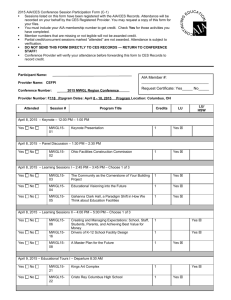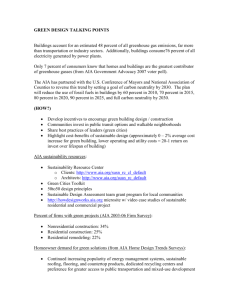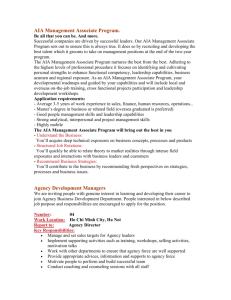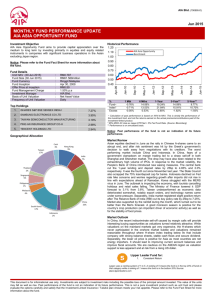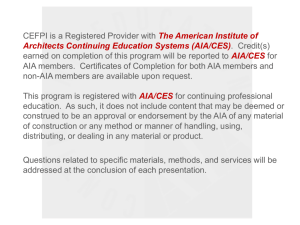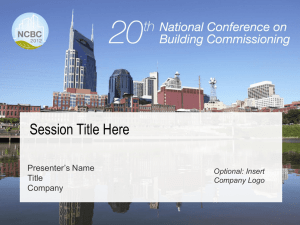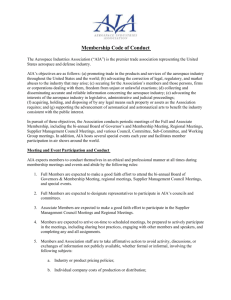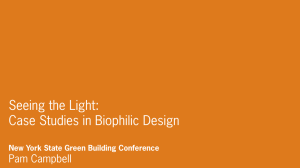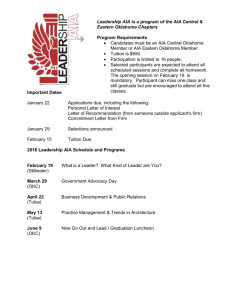AIA-NCDesc
advertisement
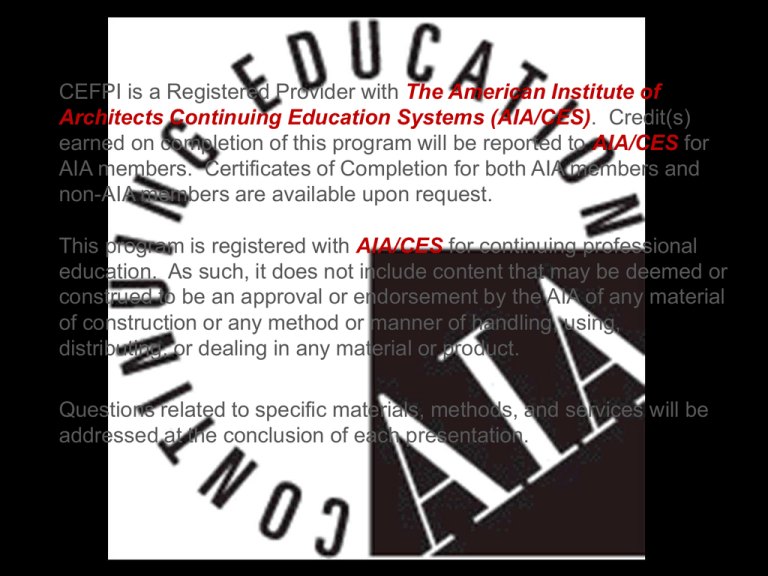
CEFPI is a Registered Provider with The American Institute of Architects Continuing Education Systems (AIA/CES). Credit(s) earned on completion of this program will be reported to AIA/CES for AIA members. Certificates of Completion for both AIA members and non-AIA members are available upon request. This program is registered with AIA/CES for continuing professional education. As such, it does not include content that may be deemed or construed to be an approval or endorsement by the AIA of any material of construction or any method or manner of handling, using, distributing, or dealing in any material or product. Questions related to specific materials, methods, and services will be addressed at the conclusion of each presentation. Learning Objectives Designing Safer, More Pleasant and More Effective Schools At the end of this program, participants will be able to: 1. Examine examples of access control types and office and work area designs that increase staff security. 2. Understand special design considerations for buildings that promote survivability of school crisis events. 3. Understand how school design impacts the critical "window of life" in the first thirty seconds of a school crisis incident. 4. Examine existing examples of safe facilities from Israel and other countries. Learning Objectives School District Safety and Security At the end of this program, participants will be able to: 1. Know about special solutions for controlling campus and building entry points. 2. Know how to designs and plan to facilitate lockdowns, based on the principle of Crime Prevention Through Environmental Design (CPTED). 3. Know about new trends and systems for campus safety and security. 4. Know how to develop and implement safety procedure for lockdowns and major critical events. Learning Objectives Design Issues related to the 2012 NC Energy Conservation Code At the end of this program, participants will be able to: 1. Understand the various compliance options available to designers. 2. Understand overall code requirements for building envelope, HVAC, electrical, and plumbing systems. 3. Understand the details of code requirements for HVAC systems. 4. Understand the design conflicts that can result for code requirements. Learning Objectives Integrated Modular Construction for Sustainable Building Interiors At the end of this program, participants will be able to: 1. Understand the environmental, HSW and financial reasons for using modular elements that integrate on a project. 2. Examine different components in an integrated modular system for interior design and construction. 3. Understand the implications of integrated modular systems and technology for the design and construction schedule. 4. Compare and contrast the wellbeing, environmental and cost benefits of this approach to conventional interior construction. Learning Objectives Geothermal Heat Pumps At the end of this program, participants will be able to: 1. Have an overview of the design process and special requirements for geothermal heat pump systems. 2. Have appropriate information for evaluating the economic attractiveness of geothermal heat pump systems for specific projects. 3. Have actual experience with well field drilling and pipe installation. 4. Share professional experiences with geothermal systems. Learning Objectives Performance Contracts and Energy Audits At the end of this program, participants will be able to: 1. Know about Building Automation and how it can improve the management of the indoor living conditions. 2. Know about Server structure hardware/software requirements for the Building Management system and the Energy Dashboard. 3. Understand Data transfer from BAS to ED and how the information can be presented. 4. Know about Energy Dashboard and LEED certification. Curriculum discussion Learning Objectives Designing Outdoor Classrooms: A School District’s Journey Through Integrating School Gardens with STEM program Instruction At the end of this program, participants will be able to: 1. Understand the environmental and health benefits, features, and design requirements of a properly functioning "outdoor classroom" and "teaching garden". 2. Understand how the components of the outdoor classroom-teaching garden impact building performance needs (i.e. use of solar collectors). 3. Gain an understanding of the number of different ways an outdoor classroom and teaching garden can impact building function and usage. 4. Learn about related trends in sustainable building (environment) occupant health and building (environment) that influence the use of outdoor classroom-teaching garden. Learning Objectives Project Based Learning Environments At the end of this program, participants will be able to: 1. Understand what experts are saying about the importance of nurturing creativity, innovation and collaboration among students. 2. Understand the ideas and thoughts behind project-based learning. 3. Understand how school districts such as Blue Valley and Whitfield County are taking these ideas/thoughts and implementing them into their curriculum. 4. Know about Blue Valley CAPS, Coahulla Creek High School and Eastbrook Middle School - all projects designed around project-based learning Learning Objectives Education Unplugged At the end of this program, participants will be able to: 1. Promote the understanding of energy use, energy efficiency and energy management. 2. Expose the potential of the collaboration with the National Building Competition and partnership with the EPA with tracking through Portfolio Manger. 3. Enhance the interest in STEM careers through hands-on experience. 4. Demonstrate energy use intensity as a factor of measurement. Learning Objectives Making a Case for a School Bond At the end of this program, participants will be able to: 1. Learn a process for the development of key features that support a Capital Improvement Plan (CIP). 2. Learn the components of the process that aid the key stakeholders in prioritizing and making decisions. 3. Understand the value of population projections and demographic analysis in supporting conclusions. 4. Understand the value in the interrelationship of capacity, student population, attendance boundaries and curriculum Learning Objectives Energy Modeling vs. Building Performance At the end of this program, participants will be able to: 1. Know what a baseline is, and how that term can be misinterpreted. 2. Know what energy modeling is, and what it is good for. 3. Know what EUI is, and what is considered a good score. 4. Know how real world buildings compare to their energy models. Learning Objectives The K-12 Performance Space At the end of this program, participants will be able to: 1. Identify the basic types of theater space configurations. 2. Identify the basic technical systems that need to be included for the operation of a K-12 performance space. 3. Identify the basic priorities for the operation of a K-12 performance space. 4. Discuss the basic programming requirements that today’s K-12 performance space (auditorium) is called upon to support.. Course Evaluations In order to maintain high-quality learning experiences, please access the evaluation for this course by logging into CES Discovery and clicking on the Course Evaluation link on the left side of the page. This concludes The American Institute of Architects Continuing Education Systems Course CEFPI
